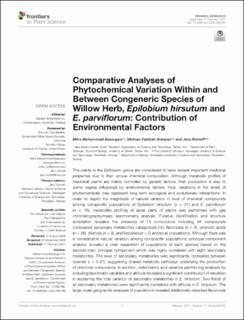| dc.contributor.author | Mohammadi Bazargani, Mitra | |
| dc.contributor.author | Falahati-Anbaran, Mohsen | |
| dc.contributor.author | Rohloff, Jens | |
| dc.date.accessioned | 2023-01-17T13:36:36Z | |
| dc.date.available | 2023-01-17T13:36:36Z | |
| dc.date.created | 2020-12-28T12:31:52Z | |
| dc.date.issued | 2021 | |
| dc.identifier.citation | Frontiers in Plant Science. 2021, 11 . | en_US |
| dc.identifier.issn | 1664-462X | |
| dc.identifier.uri | https://hdl.handle.net/11250/3044074 | |
| dc.description.abstract | The plants in Epilobium genus are considered to have several important medicinal properties due to unique chemical composition. Although metabolic profiles of medicinal plants are mainly controlled by genetic factors, their production is also to some degree influenced by environmental factors, thus, variations in the levels of phytochemicals may represent long term ecological and evolutionary interactions. In order to depict the magnitude of natural variation in level of chemical compounds among conspecific populations of Epilobium hirsutum (n=31) and E. parviflorum (n=16), metabolite profiling of aerial parts of plants was performed with GC/MS analysis. Putative identification and structure annotation revealed the presence of 74 compounds including 46 compounds considered as secondary metabolites categorized into flavonoids (n=8), phenolic acids (n=26), steroids (n=3), terpenes (n=5) across all populations. Although there was a considerable natural variation among conspecific population, principal component analysis revealed a clear separation of populations of each species based on the second main principal component which was highly correlated with 8 secondary metabolites. The level of secondary metabolites was significantly correlated between species (r=0.91), suggesting shared metabolic pathways underlying the production of chemical compounds. In addition, redundancy and variance partitioning analyses by including bioclimatic variables and altitude revealed a significant contribution of elevation in explaining total variation of secondary metabolites in E. hirsutum. Two third of all secondary metabolites were significantly correlated with altitude in E. hirsutum. The large scale geographic analyses of populations revealed additionally detected flavonoids and terpenes (E. hirsutum, and E. parviflorum) and steroid (E. hirsutum) compounds for the first time. This study provides significant information on additional chemical compounds found across the distribution range of the two ecologically important species willow herb and emphasizes the importance of geographic–wide sampling as a valuable strategy to depict intraspecific and interspecific variability in chemical traits. | en_US |
| dc.description.abstract | Comparative analyses of phytochemical variation within and between congeneric species of Epilobium hirsutum and E. parviflorum: contribution of environmental factors | en_US |
| dc.language.iso | eng | en_US |
| dc.publisher | Frontiers | en_US |
| dc.relation.uri | https://www.frontiersin.org/articles/10.3389/fpls.2020.595190/full | |
| dc.rights | Navngivelse 4.0 Internasjonal | * |
| dc.rights.uri | http://creativecommons.org/licenses/by/4.0/deed.no | * |
| dc.title | Comparative analyses of phytochemical variation within and between congeneric species of Epilobium hirsutum and E. parviflorum: contribution of environmental factors | en_US |
| dc.title.alternative | Comparative analyses of phytochemical variation within and between congeneric species of Epilobium hirsutum and E. parviflorum: contribution of environmental factors | en_US |
| dc.type | Peer reviewed | en_US |
| dc.type | Journal article | en_US |
| dc.description.version | publishedVersion | en_US |
| dc.source.pagenumber | 16 | en_US |
| dc.source.volume | 11 | en_US |
| dc.source.journal | Frontiers in Plant Science | en_US |
| dc.identifier.doi | 10.3389/fpls.2020.595190 | |
| dc.identifier.cristin | 1863496 | |
| cristin.ispublished | true | |
| cristin.fulltext | original | |
| cristin.qualitycode | 2 | |

